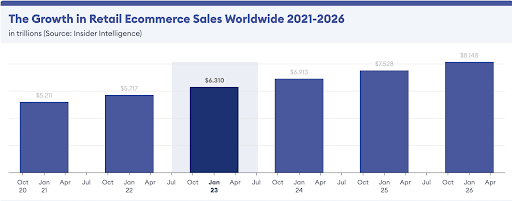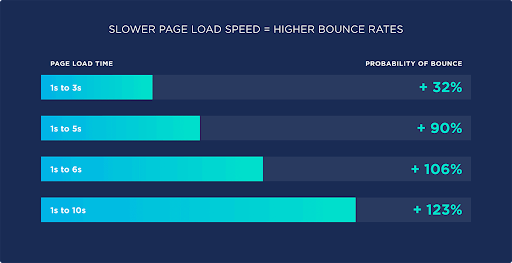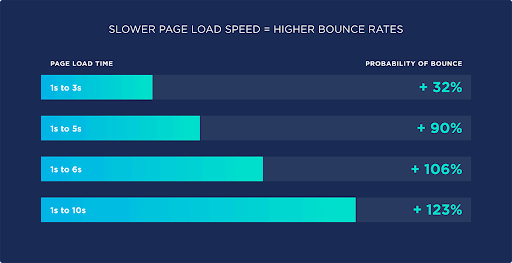
Page Speed and SEO: How to Improve E-Commerce Websites
The e-commerce industry has seen double-digit growth every year for the past decade. Expanding by 31% in just the last two years, worldwide e-commerce sales are now tipped to hit $8 trillion by 2026.

(Image Source: Forbes Business)
On the back of a post-pandemic commerce boom and a global turn to smartphone-centric shopping, the competition to score leads online has never been harder.
Consumers are more demanding, and with more industry competitors to battle against, your site has to be in tip-top shape. Your site SEO strategy plays a crucial role in your online success in 2023. If you want to improve your search engine visibility and be in with a chance of scoring conversions, all aspects of your store should be optimized for a seamless user experience.
Stick with us as we address everything from page speed to personalization in the battle to become an e-commerce industry leader.
Addressing E-commerce Competition in 2023
It’s no secret that e-commerce competition is on the rise. As the high street dwindles, we find more innovative ways to access omnichannel shopping online. Whether you tap into e-commerce through the world wide web or jump into the TikTok shop on your lunch break, digital evolution is making it easier than ever before to purchase a product/service online.
The question is, how can small business owners keep up? As industry giants like Amazon and ASOS dominate the field, it’s up to smaller industry players to match their levels of personalization and gratification and prioritize a consumer-led approach to e-commerce.
“If you’re competitor-focused, you have to wait until there is a competitor doing something. Being customer-focused allows you to be more pioneering,” says Jeff Bezos, Founder of Amazon. “We see our customers as invited guests to a party, and we are the hosts. It’s our job every day to make every important aspect of the customer experience a little bit better.”
In fact, a whopping 91% of consumers now claim that they are more likely to shop with a brand that prioritizes their personal preferences and offers a seamless experience.
Offering your target audience an effortless journey from first impression to checkout is key in 2023. With so many options at a consumer’s fingertips, it’s up to your site to provide them with an experience they can’t receive anywhere else. This means that all areas of your site must be optimized to account for customization, inclusive accessibility, and a speedy journey to conversion.
Why is Site Speed so Important?
The e-commerce industry has become an arena for instant gratification, rendering site speed a top priority for modern online shoppers.
In fact, fast-loading pages are significantly linked to e-commerce success. Not only do speedy sites encourage visitors to stay on the site for longer, but just a one-second site speed improvement could boost your conversion rate by 27%.
The question is, how does site speed affect your SEO? According to Google, page loading time is one of the key ranking factors a search engine’s algorithm takes into account when scoring site domains.
Google is constantly looking to offer its users the best possible experience. So if your page loading speed is slow, you’ll find yourself further down the search string.
Slow page loading speed also encourages a higher bounce rate. Consumers are looking for quick calls to action and an effortless path to the checkout.

(Image Source: Backlinko)
With so many industry competitors to choose from, you could lose up to 100% of your traffic if your page takes just 6 seconds to load.
“Think about your own browsing habits. If you would not wait around for a page to load, why would you expect your customers to do so? They would not either,” says Chuck Kim, Co-founder of Executive Digital. “That’s why it’s vital to understand that every customer who bounces from your site is potentially a lost sale.”
3 Ways to Keep Your On-Page SEO In Check
If you want your e-commerce site to perform well in a competitive environment, you need to regularly review your SEO practices. Not only does an SEO-optimised website provide a more seamless experience for a consumer. But it’s much more likely to be picked up by Google’s algorithm in an engine search.
Here are three ways to keep your on-page SEO in check for a faster-loading website and an e-commerce experience your consumers will come back to.
Removing Traffic Bots
In a global e-commerce landscape, online stores now find themselves flooded with traffic from a range of sources. With the ability to tap into Google from any country on any device or domain, there’s significant room for ‘botnet’ style traffic.
Not only can this clog up your server. If your site has small bandwidth, traffic bots can slow loading times down and even impact analytics metrics. This includes session duration, page views, and the geolocation of users.
Using analytic tools such as Finteza, you can swiftly detect and remove bot traffic, creating a site that runs more efficiently. As a multi-stage audience quality evaluation tool that is enabled to prioritize UTM tracking, Finteza can detect up to 12 types of dangerous or low-quality traffic sources.

Working as a webmaster’s analytic partner, Finteza produces reports in real-time. With the ability to monitor your traffic sources 24/7, the system can automatically notify you of suspicious threats and compile page-specific charts and graphs of live data.
Tracking
Better still, Finteza can even track the full path of a potential ‘bot’, making it easier to map suspicious activity. Using their Funnels feature, you can follow a bot’s journey from its source all the way to the checkout, aiding you in detecting potential fake conversions.
If you’re aiming to improve your page loading speed, removing bot traffic is essential. Not only will this help put an end to click fraud sessions, but with an accurate breakdown of your organic traffic, you’ll quickly be able to spot areas for UX improvement based on audience behavior stats.
In order to optimize your on-page SEO, it’s important to delve into organic traffic data. The more accurate your analytics are, the better your decision-making will be. Gaining knowledge about your audience’s behavior is key to improving bounce rates. Additionally, it ensures that the journey from impression to checkout is smooth and speedy.
Optimizing your Content for Mobile
It’s also important not to forget your mobile consumers when reviewing your on-page SEO. A whopping 91% of all online purchases are now made using a smartphone device. So, your e-commerce store must be fit to tackle mobile demands.
Mobile consumers are all about instant gratification. They want fast-loading content, strong visuals, and a personalized user experience during all stages of the funnel.
In fact, 40% of mobile consumers say that they will quickly jump to a competitor if a site’s smartphone-oriented UX is not up to scratch.
The key here is to start testing all areas of your website in a mobile format. Make sure images are optimized for smartphone screens and potentially larger files are compressed to ensure faster running speeds.
Investing in a Web Host
One of the quickest ways to ensure your page speed is well-optimized is to invest in a web hosting service.
As defined by Tech Radar, “Web hosting is a service that provides organizations and individuals with a platform to store their website files and make them accessible online.”
Think of it this way. If you wanted to access a file on your computer you can simply open it up. But, if you wanted to share this file with a user who is not in the room, then you’d have to send it to them.
Your website is essentially made up of files, and your web host is the sender. This allows visitors who interact with your domain to view the files in real-time. Therefore, the more powerful your hosting server, the quicker your consumers receive content.
To optimize your site for ultimate page success, it’s important to opt for a web host with large bandwidth. Plus one that can control large influxes of traffic at once. As your audience grows, your site speed should not have to suffer.
E-commerce Optimization of Tomorrow
The e-commerce industry continues to evolve. Of course, this adds SEO hurdles every step of the way, including things such as page speed.
As webmasters and site developers adapt to adhere to new devices and consumer demands, it’s important to stay ahead of the curve when it comes to on-page SEO. Ensuring that your target consumers receive the best user experience possible could be the difference between conversion and a page bounce.





